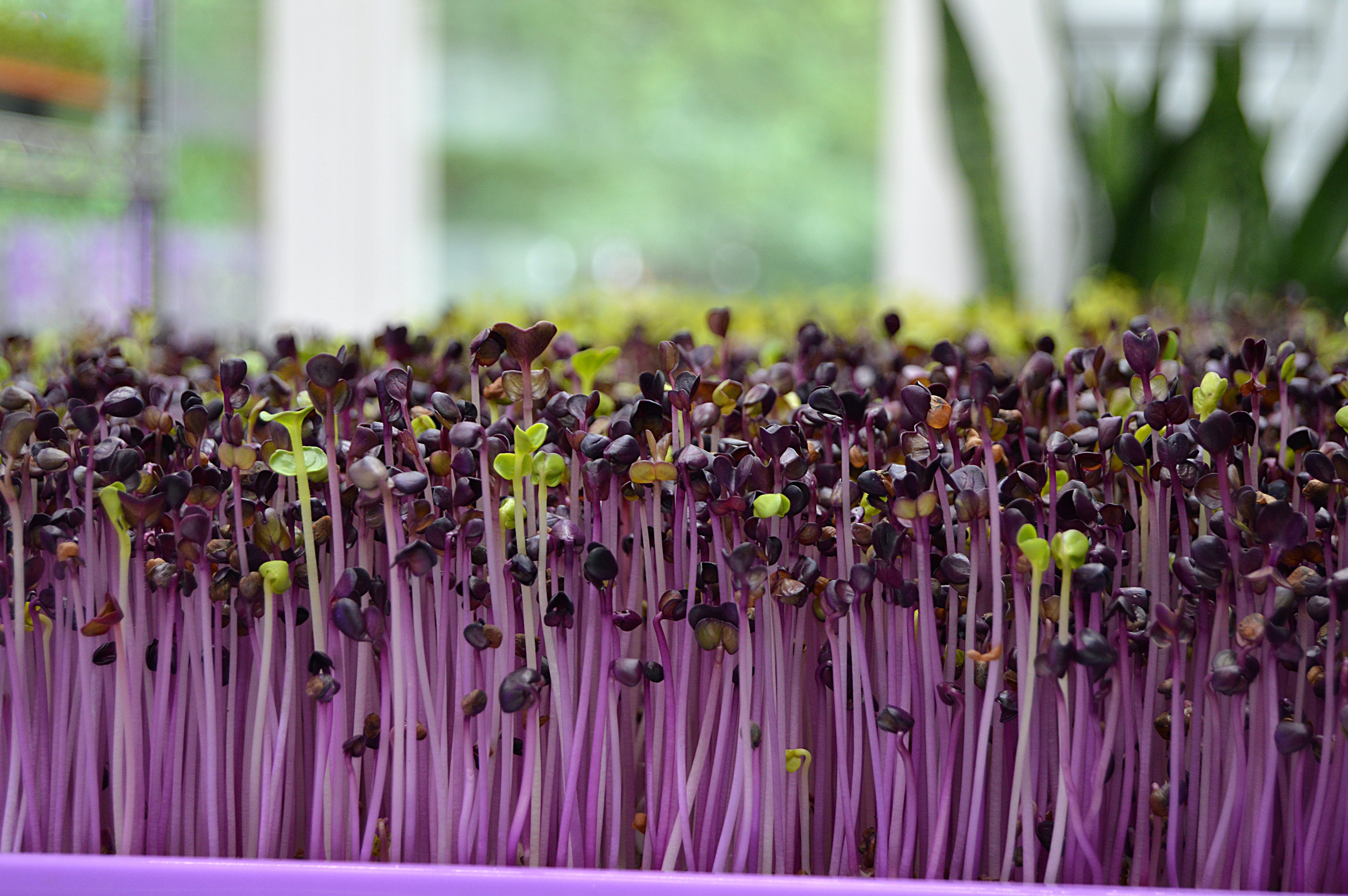This post may contain affiliate links. Please read our disclosures for more information.

When someone starts thinking about how to make money from their farm, microgreens are honestly one of the last things most farmers think of. And honestly, that’s because they’re so small! And yet, these teeny tiny crops can pump out one heck of a nice little profit.
Clearly, you’re here because you’re wondering how to grow microgreens for profit because building a profitable microgreens business sounds like a nice idea for a variety of reasons:
- Small, compact scale compared to traditional farm crops
- Unique, smaller niche product offering less competition
- Highly profitable compared to expenses to grow.
All of these neat features of microgreens make it a great crop to get started with whether you’re trying to take your farm to an income level or if you’re just looking for something fun to do as you decide to homestead.
So we called in some experts to get the answers for this tiny yet mighty topic — Katie & Jon Tlush from Tlush Family Farm.
You can listen to their podcast episode about this farm business and homemade life here:
Powered by RedCircle
We’ll dive into their interview and advice in short order, but first, let’s cover some of the basics of microgreens and their care.
Table of Contents
How To Grow Microgreens For Profit Basics:
What Are Microgreens?
You likely already knew this answer before you found this article but just in case, microgreens are small, young vegetables that are only a few inches tall at best. They’re essentially a little baby plant, something akin to a sprout.
They’re a unique little vegetable in their own way because they are nutrient-dense, full of flavor, and often highly colored, making them a beautiful visual addition to just about any dish!
While some people will simply call them “baby plants,” take note that they’re typically only a few weeks old at most when harvested for consumption.
What Plants Are Considered Microgreens?
Quite a wide range of seeds can produce a microgreen, but most fall into what people typically consider the “green veggies” category — lettuce, kale, spinach, radish greens, and arugula are common varieties, to name a few.
You can also, however, harvest microgreens from mustard plants, beets, peas, basil, cabbage, and more!
What Are Microgreens Used For?
Microgreens aren’t about to replace the lettuce in your salad, but they do add a unique flavor boost to salad and many other dishes.
A good part of their allure is the fact that you can get a beautiful variety of tender flavors and striking colors, making them a much-desired addition to soups, pasta, spreads, and more in high-end restaurants.
What Are The Benefits Of Microgreens?
Besides just looks and stronger flavor, microgreens actually DO pack in some tangible health benefits!
- May contain (concentrated) compounds that help fight cancer
- Higher vitamin and mineral concentrations than full-grown counterpart
- Higher antioxidants, and more nutritious than full-grown counterpart
- May contribute to a decrease in blood pressure and cholesterol (depends on which green)
- Considered a prebiotic (good for gut health)
How To Grow Microgreens
It’s possible that every microgreens farmer may have a slightly different exact method to how they grow microgreens, but below is the general procedure that anyone would follow.
1. Soak The Seeds
While this technically CAN be optional, you’ll get a much faster and better overall germination rate with soaked seeds. This is especially beneficial for improving the germination rate in seeds that have a harder exterior.
Soak them for 8 hours or overnight in warm water, unless the seed package instructs otherwise.
2. Prepare Your Growing Medium
Some people in home kitchen settings will simply sprout the seeds on a wet paper towel. If you’re going to grow microgreens for profit, however, you’ll want an actual growing substrate, ie dirt.
Trays can be shallow or deeper, but keep in mind that these tiny plants won’t need to grow for very long, so they won’t need the same sort of seed tray as, for example, your spring tomato plants.
You can use simple (organic) potting soil, although some growers use a soilless mix. Your choice in seed variety and the climate you’ve built for growing will influence your choices in this respect.
3. Spread Out The Seeds & Cover
Carefully and evenly spread your soaked seeds across the surface of your growing tray so that the tiny shoots won’t be clumped together when they all sprout, and cover with a fine, thin layer of soil. The blackout period will improve germination rates.
Providing a greenhouse-type cover may increase soil heat and improve germination, but this will depend on what vegetable variety you’ve used.
While some people say soil isn’t required, again, you’ll have to look into this on your own depending on your home situation. Assuming soil is used, mist the soil with a spray bottle to thoroughly moisten the soil.
4. Provide Ample Light & Water Until Harvest
Using a controlled setup with grow lights (or better, LEDs) over a shelf where your tray will rest is the best way to ensure even and consistent light exposure so your tiny greens grow evenly and well.
If you placed the tray in front of a window, for example, your sprouts would grow to one side. It’s possible they’d block each other out and give you a very uneven crop. Placing the growing tray below an LED growing light is the best way to produce as high volume and even a crop as possible.
Once sprouted, plan on watering the trays daily. The amount of water will depend on your soil medium (or lack thereof) used as well as the temperature in the growing room and the depth of the growing tray itself.
5. Harvest Microgreens
Depending on the specific variety of microgreen you grew, you’ll be harvesting sometime between one week and three weeks after sprouting, generally.
For a home application, in smaller batches, the plants may be snipped with scissors to encourage them to regrow and keep growing. In a commercial farm-to-business sales setting, they may not be snipped off the same way.
Depending on the type of microgreen you grow, they MAY regrow after the harvesting cut, but they may not. Keep in mind that a shallower tray is less likely to have enough root growth and space to regrow versus a slightly deeper tray.
How To Grow Microgreens For Profit — Business Methods & FAQ
Is It Profitable To Sell Microgreens?
Absolutely! Depending on where you live and where your farm’s market is, it’s possible to get close to $50 per pound for microgreens, although the average is around $30/pound or so.
Can Microgreens Be Grown Hydroponically?
Just about any plant on this earth can be grown hydroponically, however, each plant has different needs when it comes to the hydroponic setup. Microgreens are a little easier to grow hydroponically since they have such a short growing cycle prior to harvest, and they are a rare crop for which soil is not required.
How Much Does It Cost To Start A Microgreens Business?
This is a hugely variable answer because it’s entirely dependent on what equipment you may already have (trays, soil, lighting, etc), if you have or if you need any seeds purchased, etc.
If you’re starting from absolute zero, plan on spending a couple of hundred dollars at minimum to get the growing supplies as well as the structural supplies (shelving, lighting, etc).
How Much Money Can You Make Growing Microgreens?
The profit you generate will heavily depend on both your growing efficiency and your space availability.
If your space only allows you to grow one pound of harvested microgreens per week, you’ll expect to generate something in the neighborhood of $30 per week (given the average price listed above).
If you have room to build a much larger setup, you could potentially produce a little less than 1 pound per square foot of growing area so you can expect to earn just about $100 if you have a bit over 100 square feet.
What Do I Need To Start A Microgreens Business?
You can start with any old tray and an LED light! It’s really not anything that requires a large fancy setup.
It’s a personal decision if you’d like to operate the business as a sole proprietor and just get up and running, or if you’d feel more comfortable having more formal business structures and insurances in place prior to starting. If you’re planning to create a formal business, you would be very wise to test the waters for the market potential for the microgreens prior to paying all the business setup fees.
Which Microgreens Should I Grow?
Pretty much no one can answer this question for you.
Do you want to base your business on the ones that are fastest or easiest to grow, or the ones that are more difficult and thereby more exotic and can command a higher price?
What’s the market demand for the different microgreens? If you don’t have any customers who would want the fancy, more expensive microgreens, it isn’t wise to grow them, and hope you can convince people to pay extra for them.
As Katie discussed in our interview, some of their chefs/restaurants that buy from them have more custom blends of a few varieties, whereas they also offer a more standard few blends to be easy to purchase.
Do I Need A Special License To Sell Microgreens?
Most likely no, so long as the product is clean and free of debris. Check into your state and local laws relating to the sale of agricultural goods to ensure you’re compliant and can avoid fees and legal ramifications.
If you expand to sell the product off of your home farm, your town or state may have different requirements. Additionally, selling off the farm versus farmers markets versus to restaurants may have different requirements as well.
You may need permits to participate in farmers’ markets, so do your research carefully!
How Can I Make A Microgreens Business More Sustainable?
You will likely struggle with sustainability from the standpoint of saving your own seeds for the next crop. And that is really purely due to the nature of the crop — you’re harvesting them so young they just don’t have time to grow until they go to seed.
Your best ways to be more sustainable are to be conscientious about your expenses and be as regenerative as possible. Use better, more energy-efficient lighting, power it by solar where possible, etc.
Farmer Profile — Katie & Jon Tlush

Katie and Jon live just outside of Philadelphia, PA on just a quarter acre farm! They’ve been married for 10 years and have 2 kids age 3 and under, and they’re no strangers to chaos, hectic living, and having to bust their butts even when they’re tired. Katie stays home to raise the kids and run the farm, and Jon still works a typical day job.
They’ve got a lot more going on than just microgreens, too. In addition to microgreens, they also grow gourmet mushrooms and offer egg and salad subscriptions using their chickens and hydroponics growing.
The most impressive thing about their farm is the size of it — their entire property is only a quarter of an acre. While that offers them the space to have a flock of chickens to offer the egg subscriptions, the microgreens farm itself resides entirely in their basement! Their total growing space is less than 700 sq ft, which is a number that some people may find hard to wrap their heads around. Just goes to show you, as Katie says, that “size doesn’t matter when it comes to farming.”
Part of their basement farm is racks and racks of growing trays and LED lights to run the microgreens part of their business, and another part of their basement is a specially built and environmentally controlled fruiting chamber for the mushrooms. They grow gourmet mushrooms such as oysters, lion’s mane, and similar.
You can find them on their website, Tlush Family Farm, or you can follow them on Instagram @tlushfamilyfarm or Facebook to see their latest “tiny” adventures!







Amazing information you have listed here! Super helpful to anyone who is interested in pursuing this field. We had SO much fun doing this interview with you guys- we could have talked for DAYS! Thank you so much for hosting us and limelighting our ‘tiny- but mighty’ homestead in such a positive nature. Xxoo – Jon & Katie Tlush
Tiny but mighty is the PERFECT description of not just the farm but the impact you guys are having! We had the best time learning from you, too! <3